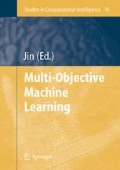Abstract
Evolutionary multiobjective optimization approach to RBF networks structure determination is discussed in this chapter. The candidates of RBF network structure are encoded into the chromosomes in GAs and they evolve toward the Pareto optimal front defined by the several objective functions with regard to model accuracy and model complexity. Then, an ensemble of networks is constructed by using the Pareto optimal networks. We discuss its application to nonlinear system identification. Numerical simulation results indicate that the ensemble network is much more robust for the case of existence of outliers or lack of data, than the one selected based on information criteria.
Access this chapter
Tax calculation will be finalised at checkout
Purchases are for personal use only
Preview
Unable to display preview. Download preview PDF.
References
Ljung L (1999) System Identification: Theory for the User, Prentice-Hall, NJ.
Nelles O (2001) Nonlinear System Identification, Springer, Berlin.
Yang Z J (1998) Identification of Nonlinear Systems, Journal of The Society of Instrument and Control Engineers, Vol.37, No.4, pp.249–255 (in Japanese).
Johansen T A (2000) Multi-objective identification of FIR models, Proceedings of IFAC Symposium on System Identification SYSID2000, Vol. 3, pp.917–922.
Johansen T A and BabuŠka R (2003) Multi-Objective Identification of Takagi- Sugeno Fuzzy Models, IEEE Transactions on Fuzzy Systems, Vol.11, No.6, pp. 847–860.
Fonseca C M and Fleming P J (1993) Genetic algorithms for multiobjective optimization : Formulation, discussion and generalization, Proceedings of the Fifth International Conference on Genetic Algorithms, pp.416–423.
Deb K (2001) Multi-objective Optimization using Evolutionary Algorithms, John Wiley & Sons, New York.
Katya R-V , Fonseca C M and Flemming P J (1997) Multiobjective Genetic Programming : A Non-Linear System Identification Application, Genetic Programming 97 Conference, pp. 207–212.
Hatanaka T, Uosaki K and Hossaka Y (2002) Application of Evolutionary Multi-Objective Optimization to Nonlinear System Identification, Proceedings of the SICE Kansai Branch Symposium 2002, pp.54–56 (in Japanese).
Chen S, Billings S A (1992) Neural networks for nonlinear dynamic system modelling and identification, International Journal of Control. Vol. 56, no. 2, pp. 319–346.
Sjoberg J, Zhang Qinghua, Ljung L, et.al. (1995) Nonlinear black-box modeling in system identification: a united overview, Automatica. Vol. 31, no. 12, pp. 1691–1724.
Abbass H A (2003) Pareto Neuro-Evolution: Constructing Ensemble of Neural Networks Using Multi-objective Optimization, Proceedings of the 2003 IEEE Congress on Evolutionary Computation, Vol. 3, pp.2074–2080.
Abbass H A (2003) Pareto Neuro-Ensemble, Proceedings of the 16th Australian Joint Conference on Artificial Intelligence, pp.554–566.
Kondo N, Hatanaka T and Uosaki K (2004) Pareto RBF Networks Based on Multiobjective Evolutionary Computation, Proceedings of 2004 SICE Annual Conference, pp.2177–2182.
Fieldsend, J E, Singh S (2005) Pareto evolutionary neural networks, IEEE Transactions on Neural Networks, Vol. 16, No.2, pp.338–354.
Hatanaka T, Uosaki K and Kuroda T (2001) Structure Selection of RBF Neural Network Using Information Criteria, Proceedings of Fifth International Conference on Knowledge-Based Intelligent Information Engineering Systems and Allied Technologies, pp.166–170.
Jin Y, Okabe T and Sendhoff B (2004) Neural network regularization and ensembling using multi-objective evolutionary algorithms, Proceedings of the 2004 IEEE Congress on Evolutionary Computation, pp.1–8.
Islam M M, Yao X and Murase K (2003) A constructive algorithm for training cooperative neural network ensembles, IEEE Transactions on Neural Networks, Vol.14, No.4, pp.820–834.
Akaike H (1974) A New Look at the Statistical Model Identification, IEEE Transactions on Automatic Control, Vol.19, pp. 716–723.
Schwarz G (1978) Estimating the Dimension of a Model, Annals of Statistics, Vol.7, No.2, pp.461–464.
Holland J (1975) Adaption in Natural and Artificial Systems, The University of Michigan Press, MI.
Bäck T (1996) Evolutionary Algorithms in Theory and Practice, Oxford Press, New York.
Ono I and Kobayashi S (1997) A Real-coded Genetic Algorithm for Function Optimization Using Unimodal Normal Distribution Crossover, Proceedings of 7th International Conference.on Genetic Algorithms, pp.246–253.
Sato H, Ono I and Kobayashi S (1997) A New Generation Alternation Model of Genetic Algorithms and Its Assessment, Journal of Japanese Society for Artificial Intelligence, Vol.12, No.5, pp.734–744.
Author information
Authors and Affiliations
Editor information
Editors and Affiliations
Rights and permissions
Copyright information
© 2006 Springer
About this chapter
Cite this chapter
Hatanaka, T., Kondo, N., Uosaki, K. (2006). Multi-Objective Structure Selection for RBF Networks and Its Application to Nonlinear System Identification. In: Jin, Y. (eds) Multi-Objective Machine Learning. Studies in Computational Intelligence, vol 16. Springer, Berlin, Heidelberg. https://doi.org/10.1007/3-540-33019-4_21
Download citation
DOI: https://doi.org/10.1007/3-540-33019-4_21
Publisher Name: Springer, Berlin, Heidelberg
Print ISBN: 978-3-540-30676-4
Online ISBN: 978-3-540-33019-6
eBook Packages: EngineeringEngineering (R0)

